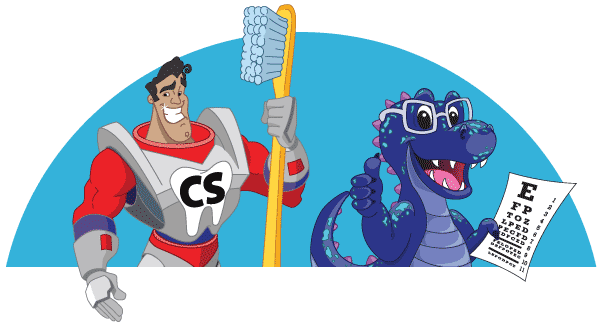Vision
Common Childhood Vision Issues

There are a variety of eye problems that can affect a child’s vision development. Eye exams early in life—every one to two years starting from six months old—are the key to early detection and effective treatment.
Vision Development Milestones
There are some very important milestones in childhood vision development, and many happen at a very early age. By one month old, babies can briefly focus on objects three feet away from them, and by three months they can already grab for something moving past them. However, it typically takes about seven years for children to fully master convergence, when both eyes focus on the same object at the same time. At your child’s annual eye exam, our optometrist will monitor these vision development milestones to identify and address any issues before they interfere with your child’s growth.
Seeing at School: Refractive disorders
Trouble seeing at school is one of the most common early indicators of kids’ vision problems. If your child starts to complain of not being able to see the board, odds are that they have developed myopia, or nearsightedness. Parents need to watch and listen to their kids closely; if your child starts to complain of eyestrain or headaches at school or is frequently squinting, they could be suffering from myopia.
Another common refractive disorder is hyperopia, or farsightedness. Uncorrected farsightedness has been proven to impact reading skills and overall school performance. Since school screenings don’t typically check for hyperopia, many children suffer academically due to uncorrected farsightedness.The final refractive disorder is astigmatism, a condition in which the transparent cornea of the eye is not rounded like a basketball, but rather is bent irregularly, like a football. Astigmatism can cause blurred vision and headaches. It can be treated with corrective lenses and can coexist with near- and/or farsightedness.
Focusing and Aligning – Common Eye Movement Issues
Early and regular eye care can detect and treat two serious eye movement conditions: amblyopia (lazy eye) and strabismus (crossed/misaligned eyes). The earlier these problems are identified and treated, the greater the possibility of correction.
Amblyopia is a condition in which one eye develops normally while the other performs at a much lower level, leading to the common name “lazy eye.” Left untreated, the child will follow the directions sent from the brain to ignore messages from the underperforming eye and rely exclusively on the healthy eye. Treatment focuses on boosting the visual acuity of the underperforming eye.
Strabismus is a problem with alignment affecting both eyes, in which the two eyes don’t focus in the same direction. Corrective lenses can often fix the problem of misalignment, or surgery is recommended in extreme cases. Like amblyopia, early treatment will greatly improve the quality of life for a child with strabismus.
Only regular comprehensive kids eye exams determine if your child is one of the 25% of children suffering from one of these common vision problems. Call today to schedule.

